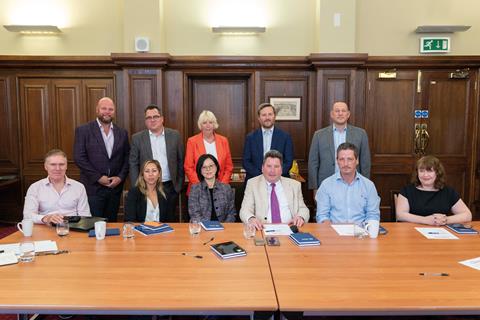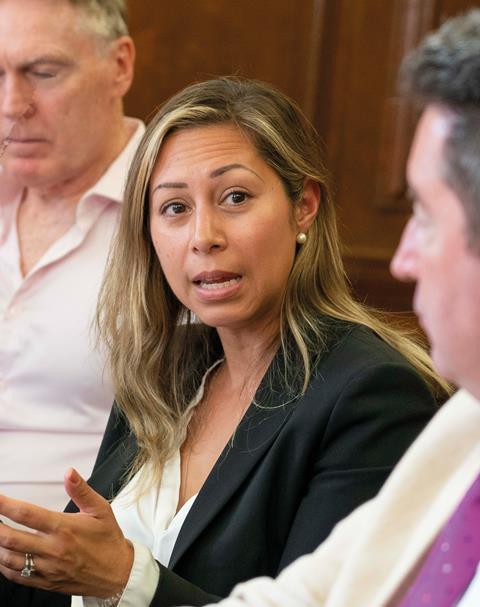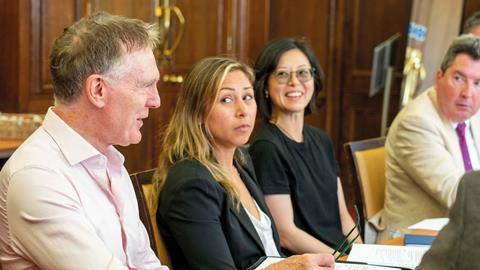Mid-sized law firms are very far from being also-rans. Eduardo Reyes finds that they are dynamic actors, finding ways to innovate and endure by utilising service, structure, technology – and even a sense of mission
At the table

Back row (l-r) Jack Newton Clio; Eduardo Reyes Law Society Gazette; Sarah Henwood Thomson Snell & Passmore; John Wallace Ridgemount; Ronnie Gurion Clio; front row (l-r) Steve Ryan SA Law; Joanne Wescott Osbornes Law; Jenny Lau iLaw; Tony Roe Dexter Montague; Lindsay Healy Aria Grace Law; Anjanette Pavell Sphere Legal
Clients report that walking into the lobby and meeting rooms of global law firms can be a same-y experience. Their locations, glass, steel, lighting and chairs feel interchangeable. The art on display is unchallenging and the views from the near-compulsory rooftop terraces reveal similar city contours. There are similar expectations of how people dress – even dress-down Friday outfits appear uniform. And the life-changingly high billable hours targets are also similar.
That is the world that several attendees at this roundtable knew as junior lawyers; before they left to join or set up firms that aim to thrive on high-quality instructions but have different ways of working, and in some cases very different aims, to their former firms. Some firms are specialist or boutique outfits. Others describe themselves as full-service firms, placing them in what is supposed to be the most awkward space of the legal market.
Thomson Snell & Passmore comfortably occupies the mid-sized, full-service ground. At 454 years old, it is the world’s oldest law firm, and it is still investing in its future, having relocated to its purpose-built Tunbridge Wells headquarters a few years ago. ‘On the corporate side, we cover real estate, dispute resolution, employment, corporate and commercial,’ chief executive Sarah Henwood explains. ‘On the private client side, it’s everything from Court of Protection and family [to] residential conveyancing and estates.’

Reading-based Dexter Montague similarly reflects how mid-size firms have shaped their offerings around client needs. It developed from a legal aid practice to one focusing on private clients and business requirements – the latter encompassing employment, litigation, property and commercial work. The 80-strong St Albans firm SA Law also combines private client services with a broad business focus.
North London firm Osbornes Law offers ‘a full range of private client services’, according to its new managing partner Joanne Wescott, encompassing ‘family… wills, trusts… residential and commercial conveyancing, litigation, housing, personal injury [and] clinical negligence’. Its headcount now stands at around 200.
John Wallace co-founded Ridgemont as a specialist law firm, acting for contractors and developers in the construction industry. Based in Cambridge and the City, iLaw markets itself to ‘innovators’, providing contentious and non-contentious advice to businesses and entrepreneurs.
Anjanette Pavell, founder and director of 30-strong Sphere Legal Ltd (formerly Co-Counsel Ltd), founded the firm based on the model of providing in-house legal services for its business clients. Aria Grace Law, co-founded by Lindsay Healy, is a not-for-profit corporate law firm with an international client base. ‘We are set up to give all of our profits to charities, mostly food banks,’ Healy says. In pursuit of that, he and colleagues are aiming for growth, targeting £500m revenue by 2031 of which £45m will go to charities.
Client pressures
Law firms of all sizes relate client pressure on fees – often at odds with increases in their own overheads. In construction and development, Wallace says clients are ‘looking for value for money more than ever. And I would say there’s pressure on the hourly rate’. His response is to structure Ridgemont in ways that keep fees down while maintaining profitability. Its lawyers are drawn from top-30 firms, he notes, but whereas competitors might charge £650 an hour for partners, Ridgemont can keep that to £400. Clients, he says, ‘want greater value, and that’s not just in terms of money. They want to know what else they can get’. Extras his firm provides might include training days and extended payment terms.
Wallace notes that while there is a push for fixed fees for non-contentious work, this model struggles to adapt to contentious matters.
Henwood says that the DNA of a mid-size firm’s clients is different from that of the magic circle firms she worked at earlier in her career. Thomson Snell & Passmore’s clients, she says, ‘have skin in the game’. Her point is that, as clients are often business owners, the ability to see their affairs in the round is at a premium and the route to becoming the ‘trusted adviser’ the client needs.
‘We spent a lot of time interviewing our clients to find out how our service is,’ Henwood says. ‘What’s good, what’s not so good and what really pisses them off. And also, what competitors are doing.’ She adds that a client’s demand will be ‘advice that I can understand and action’.
‘Over the years it has changed, the client’s expectation of a response,’ says Steve Ryan, SA Law managing partner. As an immediate response is not always possible, he says client service in this market involves ‘managing the client’s expectation and giving an acknowledgement that you’ve received their email and that you will come back to them within a defined time’.
When a client’s expectations cannot be managed, Dexter Montague partner Tony Roe reflects that the pressures that are an acknowledged part of working in a large corporate firm can manifest. ‘There’s a move since Covid… more clients seem to want you to be 24/7,’ he says.
'We are also our own worst enemy. I think a lot of those client expectations, we as an industry have driven that ourselves'
Jenny Lau, iLaw
Wescott, a fellow family lawyer, notes the peculiar pressures of their practice area: ‘We are dealing with very stressed clients in divorce and family law work. It’s so major in their lives, whether they run a big business or whether they run a fruit stall.’
Ryan reflects that a client’s expectations and appreciation of work done depend to a degree on ‘transparency’. He relates that one colleague, a residential conveyancer, shared his frustration with one ‘completely unreasonable’ client, who was just one of scores of live files the colleague was dealing with. ‘Have you told her that you’ve got 50 other live cases?’ Ryan asked him, adding that his colleague should ‘Tell her!’. The client’s response was ‘Oh my God, I had no idea’.
‘If you’re a criminal advocate and you’re on your feet in court and the client’s sat next to you, he or she can see [what you’re doing], and there’s no problem paying you,’ says Ryan. ‘If they know that you’re working on a corporate deal at 10, 11 o’clock at night and they are, say, in the corporate transaction with you, they don’t mind paying you. It’s when you do all the work, you work equally as hard and then you send the bill, and they haven’t seen the preparation or the time that’s gone into that. So, it’s a communication piece.’

‘I always find client expectations are quite interesting,’ says Jenny Lau, iLaw’s head of arbitration. ‘We are also our own worst enemy,’ she suggests. ‘I think a lot of those client expectations, we as an industry have driven that ourselves.’ Lawyers, she says, will often pick up a matter at 7pm through a sense of competitiveness, ‘fighting each other’.
What the client most wants, she says, is ‘the acknowledgement that you’ve received the email and you will deal with it’. In that regard, she says, ‘part of my work is trying to re-educate myself’.
‘When you win your work, ask them what they think they’ve bought,’ Henwood advises, ‘because there’s sometimes, straight off, a disconnect between what they’re expecting and what you’re going to deliver. So, if you have clear expectations on both sides on how the matter will run, how the communication will be… then you have set the parameters before you start.’
There can be an awkwardness around billing a client. Henwood recommends: ‘Ring them up and remind them of the value that you delivered during that transaction.’
Good communication, Wescott notes, is also relevant to managing stress, wellbeing and work-life balance. ‘I have a young family, so I can’t be contacted 24/7,’ she says.
She stresses the importance of setting boundaries at the outset, ‘explaining the way I work is that I will very much down tools at 5 o’clock. Between 5pm and 7pm, you cannot contact me, but I will pick up in the evening and I will be online and working in the evening, but not to have a conversation with you… it’s all about managing relationships’.
Home and away: Sabbaticals
‘There’s a real divide’ over whether law firms should allow sabbaticals, says Osbornes Law managing partner Joanne Wescott. ‘Most people are against it. They think it’s an absolute nightmare to manage.’
Her firm, by contrast, is unfazed: ‘We manage maternity leave, we manage paternity leave, we manage parental leave. If that person is coming back refreshed, raring to go, then I don’t see an issue with it.’
She raises the topic because she is keen to hear the views of leaders from other mid-size law firms.
One of the challenges these practices face when offering people sabbaticals is that having a small number of specialists in some teams makes providing cover a challenge. However, firms that offer sabbaticals acknowledge there are benefits.
‘We provide sabbaticals, and they are a nightmare to manage,’ Sphere Legal’s Anjanette Pavell admits. ‘You’re losing someone that usually is ingrained in your business and has a following, and that you depend on.’
And yet, she says: ‘Giving that person the freedom to go and do something else with their time, I think, really pays dividends. We haven’t had anyone take a sabbatical who hasn’t come back. For me, that’s the proof of the pudding.’

Technology
The ‘communication’ discussed by attendees is intertwined with the growing and changing use of technology in the legal sector. Jack Newton, founder of Clio, sponsor of this roundtable, highlights a generational move away from email as a preferred communication route. ‘Email’s like your post box where it’s mostly junk mail now,’ he says. ‘The signal-to-noise ratio is just not what it used to be.’
As a result, ‘text messaging is… a preferred modality for anyone millennial or younger these days’. But an approach in which lawyers give out their personal phone numbers or WhatsApp to clients is ‘a bug and a flaw’, given the need to keep track of instructions and time.
‘It’s not just the fact that these communications are all non-billable,’ he adds. ‘They’re also not visible by the firm and nobody can see what’s the thread of communication with the firm.’ Newton predicts that there will be much wider adoption of ‘technology available that allows you to text message, see the full track record of all the text message communications that the firm has had with these clients and, also, attach billable time’.
'In the first few years, we did what every law firm does. We worked with Microsoft and tried to create things from there. Microsoft still forms the basis of most of our work'
Lindsay Healy, Aria Grace Law
What mid-sized firms are unable to do is commit large sums to developing the kinds of proprietary technology many large firms have. Technology priorities in this part of the market are different, Healy notes.
‘In the first few years, we did what every law firm does,’ he says. ‘We worked with Microsoft and tried to create things from there. Microsoft still forms the basis of most of our work,’ he continues, but Clio has been added for law practice management tasks. He believes it is a platform that can grow with the firm. ‘Getting onto the Clio platform, which we’ve been on for over a year now, has been just easy… We have two demands: simplicity and security.’

Regarding artificial intelligence (AI), Healy says that there is no appetite to create products with this technology, unlike global elite firms. ‘When we talk about AI we look to our vendors to… tell us how to use it,’ he says.
Widely available technology can bring benefits without loosening the connection between lawyers and their clients, Roe reflects. In family law, he will still build the necessary rapport with a client face to face. But with platforms like Zoom and Teams, ‘the days of trudging up to the barrister’s chambers with a massive suitcase with all your files in it, in case that one piece of paper is missing, are just long gone’.
‘In some ways,’ Ryan adds, ‘a lot of the systems that firms like ours can deploy can be quite agile, because we are smaller and it’s easier to turn that ship than it is a tanker.’
Pavell says that because Sphere Legal is ‘a technology firm, we’re involved often in business process design – [clients] that have large volumes of contracts or other workloads that they need to manage’. She adds: ‘We’ve had the benefits of being on various presentations by different [technology] providers of what they can do.’
In her view, for colleagues and their clients: ‘Very often, the technology that’s available is too big for the task, and it’s quite hard for those providers to help potential clients understand how it could benefit them and what usability they can expect to see… over time.’
Artificial intelligence
On the adoption of AI, Henwood says: ‘Our approach is very much [to ask], “What is the problem we’re trying to solve?” because there is so much AI out there that can be used. You can be quite dazzled by it.’ The firm allows its people to use ChatGPT, ‘because people are going to use it’, but it sets very strict guidelines around what is entered into ChatGPT and around declaring that it was used in completing a task.
The adoption of AI is happening at pace. Newton references research Clio conducted with US law firms. ‘In just a year, usage of AI in law firm workflows went from 25% to 75% of surveyed firms. If you compare that adoption curve to the cloud, it’s like a vertical line. It took the cloud about 15 years to reach that same level of adoption, and we’ve seen AI reach it in about 15 months.’
'AI might finally be the death knell for the billable hour because there’s going to be a large disconnect between the value law firms are delivering and the value being reflected in the billable hour model'
Jack Newton, Clio
Maybe the pace of adoption by this traditionally conservative profession should not come as a surprise. After all, legal matters come down to documents. Large language model AI systems, such as ChatGPT, draw from documents made available to them. The 75% adoption established in the Clio research falls to 65% for industry at large.
‘Where AI sings today,’ Newton says, ‘is in fields where the inputs and outputs are text, and that’s what law is all about. The technology resonates most with the domain of legal, and lawyers recognise its value in streamlining and assisting their work, whether it’s generating, summarising, or analysing documents.’
Looking ahead, Newton speculates: ‘AI might finally be the death knell for the billable hour because there’s going to be a large disconnect between the value law firms are delivering and the value being reflected in the billable hour model. Fixed-fee billing, which many firms are already embracing, may become even more common as AI further automates workflows and reduces reliance on hourly billing.’

Culture and wellbeing
There is an expectation that while mid-sized practices cannot compete with largest firms in terms of financial rewards, by controlling the work environment in positive ways, they can compete on retention and recruitment.
But the benefits of a good workplace culture are not automatic, and establishing such an environment means working through some conflicting priorities. The Covid-19 lockdowns provided a proof of concept of remote working. ‘It did validate remote working,’ Healy says, adding that his firm does not have a traditional head office.
Remote and flexible working can and should be part of a positive workplace culture. But that requires managing. Wescott reflects that productivity at her firm went up during lockdowns, as did profitability. ‘People were working much longer hours. They were available 24/7,’ she says, but ‘it wasn’t a healthy way to work.’
'People are just as productive at home, and we don’t need to force office attendance'
Joanne Wescott, Osbornes Law
When lockdowns were over and greater home working had become normal, Wescott’s firm did a productivity survey. ‘What we expected was, because our attendance in the office was higher on a Tuesday, Wednesday, Thursday, naturally we thought, on Monday and Friday, productivity was going to be [lower]… actually, it was the opposite.’ Monday was the most productive day. As a result, she says: ‘We’ve left it alone, because it showed people are just as productive at home, and we don’t need to force office attendance.’

‘Culture for us,’ Henwood says, ‘is really, really important, and we spend a lot of time investing in that culture. Because we are employing people, and people are our asset, we really, really care for them.’ But there is no avoiding the fact, she notes, that ‘the legal job that you’ve taken is a tough gig’. As a result, a particular focus for her is supporting people’s resilience, ‘making sure that people are equipped and know how to behave, [how to] manage their time’.
In conclusion, several attendees note that the ‘benefits’ of their work, include doing a good job for a client. As Ryan puts it: ‘The energy you get from assisting a client, I think it’s the most rewarding part of the job.’
Photographs by Noah Da Costa
This roundtable discussion was kindly sponsored by Clio





































No comments yet